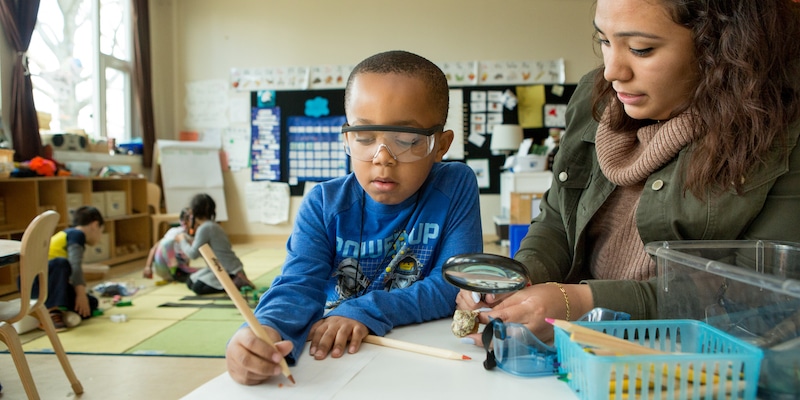We’re swimming in a world of technologies that have huge implications for the future of schooling. Computers live in teachers and students’ pockets, the Internet makes information and media ubiquitous commodities, apps offer to aid with all our daily routines, and artificial intelligence unlocks new possibilities for differentiated instruction.
Yet even with these technologies flooding into schools and classrooms, computers won’t be replacing teachers any time soon, and that’s why now, more than ever, teachers should be given the critical support they’re asking for in the classroom. To illustrate this point, consider these three things educational technology can’t do.
1. Technology can’t … provide higher-order feedback
Software is great for generating immediate, automated feedback on students’ mastery of basic knowledge and skills. But higher-order feedback falls outside its purview.
Consider, for example, essay grading. For years, word processors have been able to point out corrections for spelling and grammar errors; and more recently, intelligent software now offers feedback on elements of structure and style—such as whether a student has a topic sentence at the beginning of each paragraph and whether each paragraph contains evidence related to the topic sentence and the essay’s thesis. But software cannot give feedback on many of the qualities that really define great writing—such as whether the students’ rhetoric and logic will resonate with her intended audience. It takes a human to give feedback on the more nuanced aspects of human communication.
The same holds true in other academic domains. Software can’t tell students if their research questions for a science project are worthwhile and reasonably scoped; nor can it tell them which engineering and design challenges they should tackle to improve a simple machine. And software can’t coach soft skills—such as working effectively in teams, navigating interpersonal conflict, setting personal goals, and persevering through obstacles. In sum, the skills students will need to future-proof their careers against the rise of machines are also the skills they can’t learn from machines.
2. Technology can’t … get to know a student
Software today can potentially access a lot of data about a student: home address, race and ethnicity, diagnosed learning disabilities, family income, attendance records, test scores, browser history, and even keystrokes and mouse clicks. But with all that data, can software really know a student? Can a computer understand how his social status at school leads him to feel when he’s assigned to work with a particular group of peers on a class project? Or can it predict that she’ll enjoy reading a particular novel because it reminds her of her best friend from the town where she used to live? Software can make a lot of useful inferences based on patterns it finds in the data it collects. But it can’t collect data on all the important factors that shape a students’ learning experiences, nor can it model all of the psychological complexity of childhood and adolescence. Real knowing and understanding is a human-to-human experience.
3. Technology can’t … care about a student
Where do students get the motivation to learn? At times motivation may come from pure intellectual curiosity. But more often than not, motivation comes from relationships. For example, a student stays after class for extra tutoring because he cares what his parents think of his grades and he believes his teacher’s confidence that a little extra practice will help him get the grades he wants. Or a student becomes excited about science because a teacher who cares deeply about her also cares deeply about science. Students often work to learn and to achieve for the praise and approbation of people who matter in their lives. Software, for all its wondrous abilities, can’t offer that sense of genuine caring.
But teachers can’t …
As the examples above make clear, teachers shouldn’t worry about software and devices taking their jobs. The kind of sci-fi-level artificial intelligence that might do the things described above is a long way off. This means the odds of teachers being replaced by machines are pretty slim. Teachers are a performance-defining feature in even the most technologically sophisticated learning environments. Any edtech aimed at replacing teachers sets a low bar for quality education.
But here’s the rub: while software can’t do the things listed above, neither can most teachers. For teachers, however, it isn’t a matter of capability, but a matter of capacity. How often do English teachers conference individually with their students about the quality of their rhetoric, especially when correcting grammar and structure already takes up so much of their time? How many teachers have time to meet regularly with each of their students one-on-one just to ask about how they’re doing, let alone attend all their students’ extracurricular activities or visit their students’ homes to get to know their families? Caring about students isn’t constrained by time, but showing that you care is. Unfortunately, when push comes to shove, most teachers’ days quickly fill up with planning lessons, writing quizzes, running copies, covering content, participating in staff meetings, and grading lower-order assignments; with little time left for many of the high-value activities described above.
This is why edtech is so important for teachers, in spite of all the things it can’t do. If we want all students to thrive in an increasingly complex world, we need teachers to spend more time developing students’ higher-order skills, tailoring learning to their personal circumstances, and building strong relationships with them. A key way to unlocking teachers’ capacity comes from using technology to take lower-order work off teachers’ plates.
In short, educators need technology to automate some of their work so they can focus on the important work technology can’t do. For anyone interested in advancing this idea, we’re developing a new framework to help educators think about how technology amplifies teacher capacity. We’d love to hear what you think.
A version of this post originally appeared on The 74 Million. Photo courtesy of Allison Shelley/The Verbatim Agency for American Education: Images of Teachers and Students in Action.



